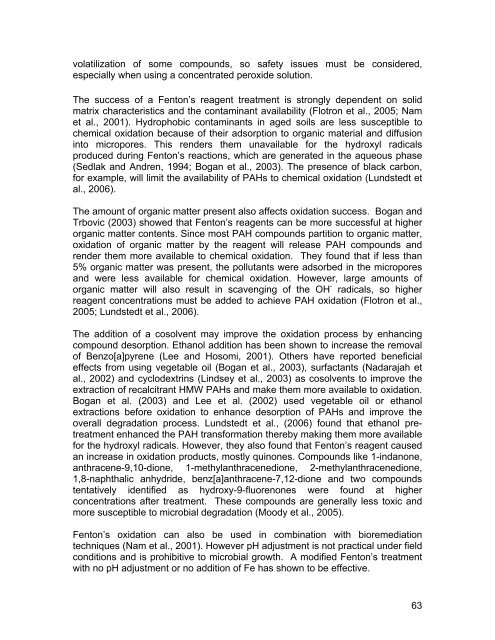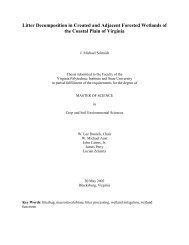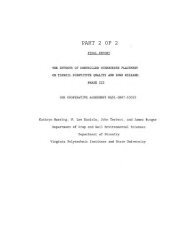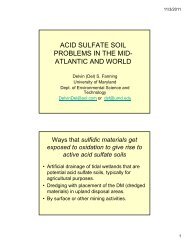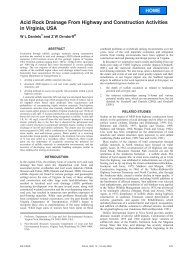Remediation of PAH-Contaminated Soils and Sediments: A ...
Remediation of PAH-Contaminated Soils and Sediments: A ...
Remediation of PAH-Contaminated Soils and Sediments: A ...
You also want an ePaper? Increase the reach of your titles
YUMPU automatically turns print PDFs into web optimized ePapers that Google loves.
volatilization <strong>of</strong> some compounds, so safety issues must be considered,<br />
especially when using a concentrated peroxide solution.<br />
The success <strong>of</strong> a Fenton’s reagent treatment is strongly dependent on solid<br />
matrix characteristics <strong>and</strong> the contaminant availability (Flotron et al., 2005; Nam<br />
et al., 2001). Hydrophobic contaminants in aged soils are less susceptible to<br />
chemical oxidation because <strong>of</strong> their adsorption to organic material <strong>and</strong> diffusion<br />
into micropores. This renders them unavailable for the hydroxyl radicals<br />
produced during Fenton’s reactions, which are generated in the aqueous phase<br />
(Sedlak <strong>and</strong> Andren, 1994; Bogan et al., 2003). The presence <strong>of</strong> black carbon,<br />
for example, will limit the availability <strong>of</strong> <strong>PAH</strong>s to chemical oxidation (Lundstedt et<br />
al., 2006).<br />
The amount <strong>of</strong> organic matter present also affects oxidation success. Bogan <strong>and</strong><br />
Trbovic (2003) showed that Fenton’s reagents can be more successful at higher<br />
organic matter contents. Since most <strong>PAH</strong> compounds partition to organic matter,<br />
oxidation <strong>of</strong> organic matter by the reagent will release <strong>PAH</strong> compounds <strong>and</strong><br />
render them more available to chemical oxidation. They found that if less than<br />
5% organic matter was present, the pollutants were adsorbed in the micropores<br />
<strong>and</strong> were less available for chemical oxidation. However, large amounts <strong>of</strong><br />
organic matter will also result in scavenging <strong>of</strong> the OH - radicals, so higher<br />
reagent concentrations must be added to achieve <strong>PAH</strong> oxidation (Flotron et al.,<br />
2005; Lundstedt et al., 2006).<br />
The addition <strong>of</strong> a cosolvent may improve the oxidation process by enhancing<br />
compound desorption. Ethanol addition has been shown to increase the removal<br />
<strong>of</strong> Benzo[a]pyrene (Lee <strong>and</strong> Hosomi, 2001). Others have reported beneficial<br />
effects from using vegetable oil (Bogan et al., 2003), surfactants (Nadarajah et<br />
al., 2002) <strong>and</strong> cyclodextrins (Lindsey et al., 2003) as cosolvents to improve the<br />
extraction <strong>of</strong> recalcitrant HMW <strong>PAH</strong>s <strong>and</strong> make them more available to oxidation.<br />
Bogan et al. (2003) <strong>and</strong> Lee et al. (2002) used vegetable oil or ethanol<br />
extractions before oxidation to enhance desorption <strong>of</strong> <strong>PAH</strong>s <strong>and</strong> improve the<br />
overall degradation process. Lundstedt et al., (2006) found that ethanol pretreatment<br />
enhanced the <strong>PAH</strong> transformation thereby making them more available<br />
for the hydroxyl radicals. However, they also found that Fenton’s reagent caused<br />
an increase in oxidation products, mostly quinones. Compounds like 1-indanone,<br />
anthracene-9,10-dione, 1-methylanthracenedione, 2-methylanthracenedione,<br />
1,8-naphthalic anhydride, benz[a]anthracene-7,12-dione <strong>and</strong> two compounds<br />
tentatively identified as hydroxy-9-fluorenones were found at higher<br />
concentrations after treatment. These compounds are generally less toxic <strong>and</strong><br />
more susceptible to microbial degradation (Moody et al., 2005).<br />
Fenton’s oxidation can also be used in combination with bioremediation<br />
techniques (Nam et al., 2001). However pH adjustment is not practical under field<br />
conditions <strong>and</strong> is prohibitive to microbial growth. A modified Fenton’s treatment<br />
with no pH adjustment or no addition <strong>of</strong> Fe has shown to be effective.<br />
63


